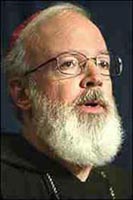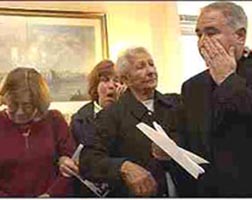 |
NEWS: October 14, 2004
Bird’s Eye View of the News
Atila Sinke Guimarães
CLOSING CHURCHES: INCONGRUENT ARGUMENTS - Archbishop Sean O’Malley of Boston forges ahead with the agenda of closing churches. He is locking 82 of the 357 parishes of the Archdiocese. “The Archdiocese is no longer able to support struggling parishes, many of which are in older buildings in need of repairs,” he said (The Tablet, August 28, 2004, p. 28). But it is not just struggling parishes O’Malley is closing. He is shutting down flourishing parishes, such as St. Albert the Great Church, which had its last Mass August 29. Its parishioners protested that the church does not fit the low-attendance or aging-building criteria issued by the Archdiocese. The parish is self-sustaining with 1,600 families, a paid-off mortgage, money in the bank, and renovated buildings.
 
O'Malley, left, goes ahead with church closings, despite the protests. Right, Parish priest and people of St. Catherine of Sienna Church reactions - Boston Globe photos |
In face of this arbitrary procedure of O’Malley, the parishioners went to court September 8 to file a lawsuit claiming that the church buildings, the land on which they are situated, and the parish assets are owned by the parishioners, not by the Archdiocese. Attorney Mary Ames, representing St. Albert’s parishioners, asked Judge Thomas Connolly to issue a preliminary injunction stopping the Archdiocese from selling off any of the property or assets of the parish.
Archdiocese lawyer Wilson Roger defends O’Malley’s action: “The parish has been suppressed. The Archbishop of Boston has the legal title to this property.” He argues that the closing and subsequent transfer of property to the Archdiocese is an internal Church matter over which the court should have no jurisdiction (National Catholic Reporter, September 17, 2004).
Who owns the property of a parish is an interesting juridical point to discuss, without a doubt. An impartial analysis of the customary rights of the parishioners and the canonical rights of the Diocese would most probably conclude that while it is true that a parish does not exist without the ministry of priest, it also does not exist without the attendance and financial support of the faithful. It is a kind of marriage in which both sides have rights. One side cannot advocate complete ownership without damaging the other. In my opinion, it is, first, a matter of Natural Law and, second, a question of Canonical Law.
But my concern here is not to enter into the juridical discussion of pros and cons. My point is to point out a fundamental contradiction in this progressivist Church that took over the Catholic Church in the ‘60s. Put this church closing case side-by-side with the incident below, and the contradiction jumps out.
It is known that Archbishop John Viazny of Oregon filled for bankruptcy to escape the financial costs mounting from the sexual abuse by priests. The Archdiocese went under the protection of Chapter 11, which means that its assets are under the supervision of the civil authority. The Archdiocese of Oregon had to abdicate control over its possessions, but it refused to relinquish control of its parishes, schools, and respective assets because it argued Canon Law holds that parish and school assets belong to the parishes and schools, and not the Archdiocese (America, August 30, 2004, p. 4).
That is, the representatives of the Church are using one argument in Oregon to favor themselves, and the precise opposite argument in Boston, again, to favor themselves. It hardly seems an honest procedure. Sad, but, alas, the reality.
It is no surprise that the only recourse for the faithful is to protest and recur to the Civil Law.
PRIEST SHORTAGE AND THE SACRAMENTS – An event of interest regarding not only the future of British Catholics, but also Catholics worldwide, took place in London September 6-10. The National Conference of Priests of England and Wales (NCP) met to discuss implications of the priest shortage in the distribution of the Sacraments to the faithful. The presuppositions of those present were three-fold:
• The number of priests is highly disproportionate to the number of the faithful;
• the average age of the Catholic clergy is rising higher by the day;
• the increasing number of younger priests on leave due to child abuse allegations, alcoholism, and mental problems makes the shortage still more acute.
In face of this situation, the Church’s procedure in distributing Sacraments is changing.
One specific problem raised by the participants, according to The Tablet (September 18, 2004, pp. 33-4), was the lack of conditions to maintain full-time chaplains in every hospital to give the Sacraments to the sick and dying. How to resolve this problem? The report did not offer any official conclusions of the NCP, but notably it pointed out the suggestions of several priests. They included:
• Make priests available through electronic devices (pagers, cellular phones, etc).
• If it is not possible to visit the dying, comfort and relieve the family members by telephone.
• Move toward “generic Christian” chaplains, which means the use of Anglican pastors to spiritually assist the Catholic dying.
To resolve the general problem of the priest shortage, conference participant-priests suggested “new models” to think about for the future. They were:
• ordaining married men;
• merging two or more parishes into one;
• organizing parish life without a priest.
These “new models” fit quite precisely into the progressivist agenda that aims to transform the solid sound structure of the Catholic Church into an invertebrate organization of small cells – the Basic Christian Communities or the like. Not only in England and Wales, but everywhere.
Quite curiously, this agenda was prepared by progressivist theologians when the Church was very far from having the priest shortage problem she is experiencing today. Please, read Cardinals Yves Congar’s and Joseph Ratzinger’s clear statements on the topic (click here). Therefore, we have the classic question of who came first: the chicken or the egg? Was it the progressivist agenda that created the shortage of priests? Or is this shortage being taken advantage of to promote the progressivist agenda? I leave the answer to the reader.


Related Articles of Interest
 Closing Churches Closing Churches
 Estate Liquidation in the Archdiocese of New York Estate Liquidation in the Archdiocese of New York

|
News | Home | Books | CDs | Search | Contact Us | Donate

© 2002- Tradition in Action, Inc. All Rights Reserved
|
 |
|